Leadership & Management: Business Process Management Assignment
VerifiedAdded on 2023/06/12
|8
|1123
|437
Homework Assignment
AI Summary
This assignment solution delves into various aspects of Business Process Management (BPM), starting with concise answers to questions covering BPM definition, vision importance, design phase, process mapping, 'what if' analysis, process mining, and the Six Sigma approach, including the distin...
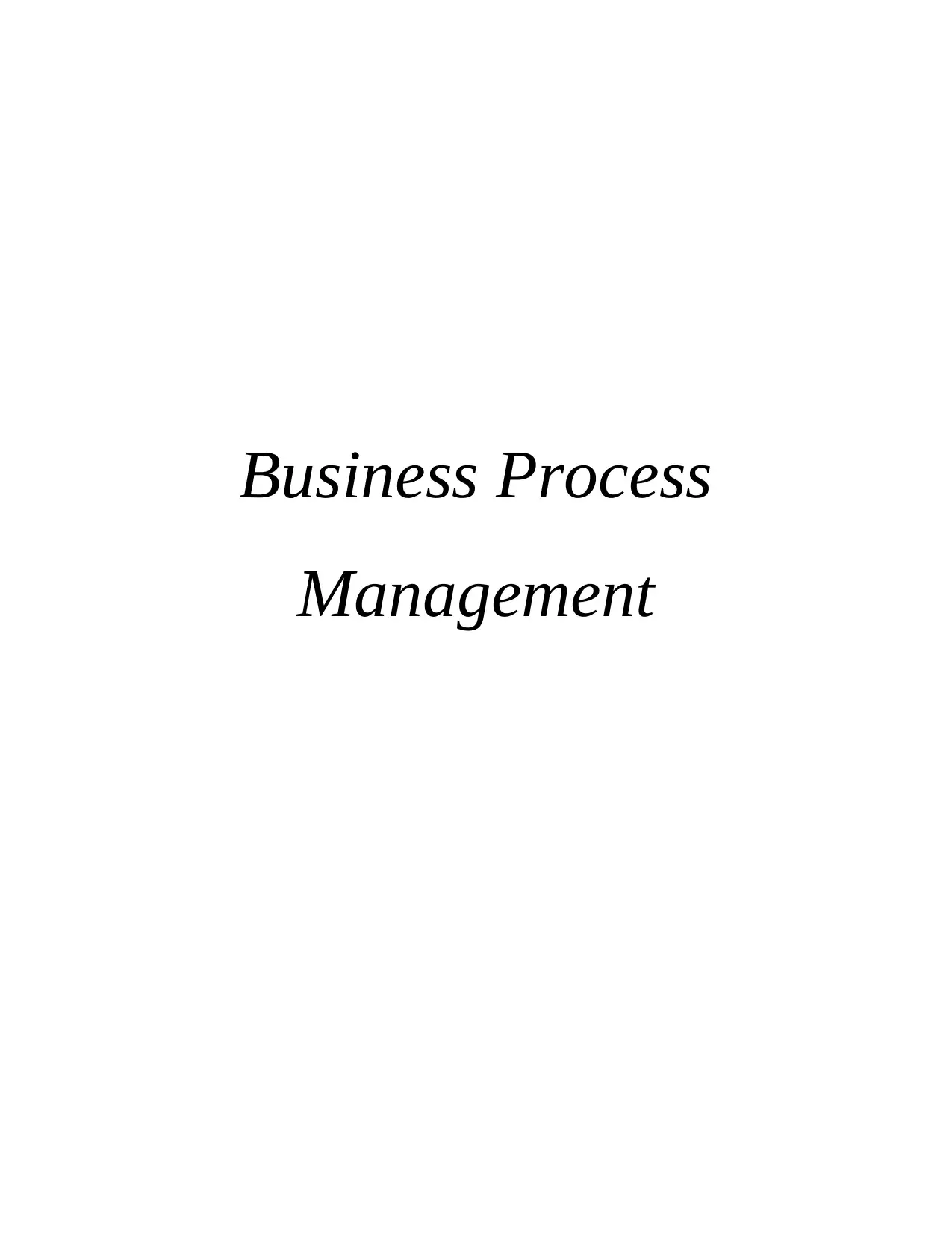
Business Process
Management
Management
Paraphrase This Document
Need a fresh take? Get an instant paraphrase of this document with our AI Paraphraser
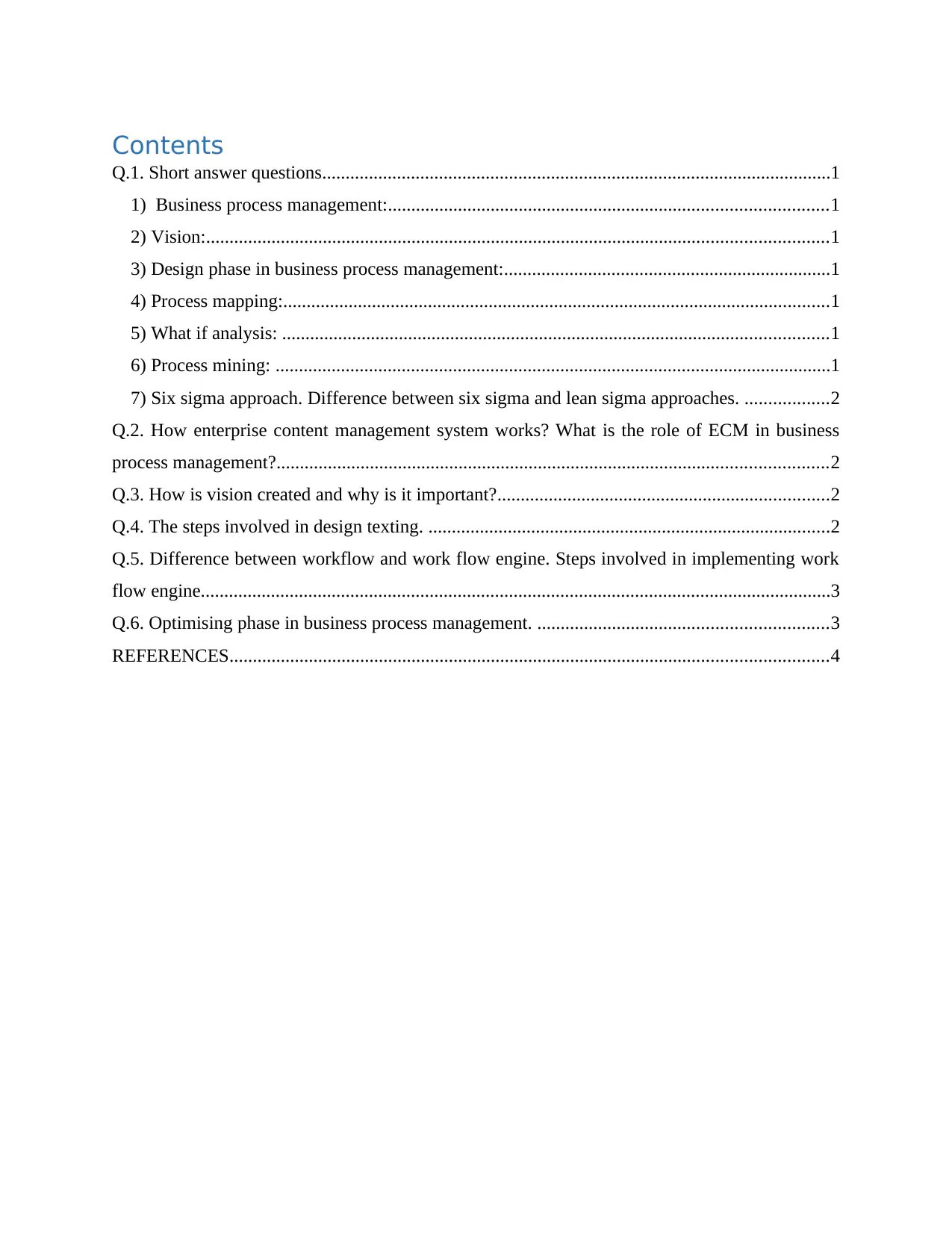
Contents
Q.1. Short answer questions.............................................................................................................1
1) Business process management:..............................................................................................1
2) Vision:.....................................................................................................................................1
3) Design phase in business process management:......................................................................1
4) Process mapping:.....................................................................................................................1
5) What if analysis: .....................................................................................................................1
6) Process mining: .......................................................................................................................1
7) Six sigma approach. Difference between six sigma and lean sigma approaches. ..................2
Q.2. How enterprise content management system works? What is the role of ECM in business
process management?......................................................................................................................2
Q.3. How is vision created and why is it important?.......................................................................2
Q.4. The steps involved in design texting. ......................................................................................2
Q.5. Difference between workflow and work flow engine. Steps involved in implementing work
flow engine.......................................................................................................................................3
Q.6. Optimising phase in business process management. ..............................................................3
REFERENCES................................................................................................................................4
Q.1. Short answer questions.............................................................................................................1
1) Business process management:..............................................................................................1
2) Vision:.....................................................................................................................................1
3) Design phase in business process management:......................................................................1
4) Process mapping:.....................................................................................................................1
5) What if analysis: .....................................................................................................................1
6) Process mining: .......................................................................................................................1
7) Six sigma approach. Difference between six sigma and lean sigma approaches. ..................2
Q.2. How enterprise content management system works? What is the role of ECM in business
process management?......................................................................................................................2
Q.3. How is vision created and why is it important?.......................................................................2
Q.4. The steps involved in design texting. ......................................................................................2
Q.5. Difference between workflow and work flow engine. Steps involved in implementing work
flow engine.......................................................................................................................................3
Q.6. Optimising phase in business process management. ..............................................................3
REFERENCES................................................................................................................................4
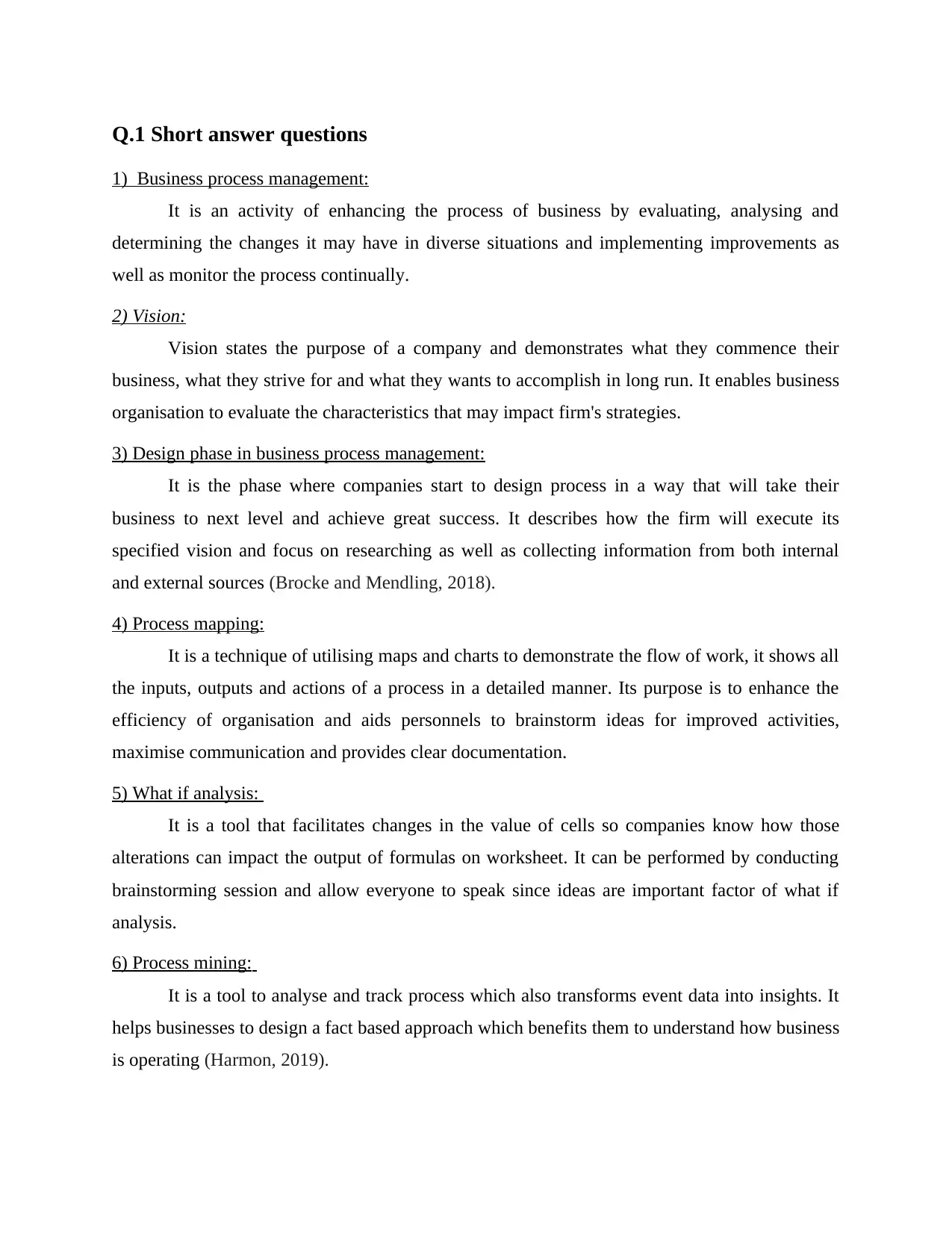
Q.1 Short answer questions
1) Business process management:
It is an activity of enhancing the process of business by evaluating, analysing and
determining the changes it may have in diverse situations and implementing improvements as
well as monitor the process continually.
2) Vision:
Vision states the purpose of a company and demonstrates what they commence their
business, what they strive for and what they wants to accomplish in long run. It enables business
organisation to evaluate the characteristics that may impact firm's strategies.
3) Design phase in business process management:
It is the phase where companies start to design process in a way that will take their
business to next level and achieve great success. It describes how the firm will execute its
specified vision and focus on researching as well as collecting information from both internal
and external sources (Brocke and Mendling, 2018).
4) Process mapping:
It is a technique of utilising maps and charts to demonstrate the flow of work, it shows all
the inputs, outputs and actions of a process in a detailed manner. Its purpose is to enhance the
efficiency of organisation and aids personnels to brainstorm ideas for improved activities,
maximise communication and provides clear documentation.
5) What if analysis:
It is a tool that facilitates changes in the value of cells so companies know how those
alterations can impact the output of formulas on worksheet. It can be performed by conducting
brainstorming session and allow everyone to speak since ideas are important factor of what if
analysis.
6) Process mining:
It is a tool to analyse and track process which also transforms event data into insights. It
helps businesses to design a fact based approach which benefits them to understand how business
is operating (Harmon, 2019).
1) Business process management:
It is an activity of enhancing the process of business by evaluating, analysing and
determining the changes it may have in diverse situations and implementing improvements as
well as monitor the process continually.
2) Vision:
Vision states the purpose of a company and demonstrates what they commence their
business, what they strive for and what they wants to accomplish in long run. It enables business
organisation to evaluate the characteristics that may impact firm's strategies.
3) Design phase in business process management:
It is the phase where companies start to design process in a way that will take their
business to next level and achieve great success. It describes how the firm will execute its
specified vision and focus on researching as well as collecting information from both internal
and external sources (Brocke and Mendling, 2018).
4) Process mapping:
It is a technique of utilising maps and charts to demonstrate the flow of work, it shows all
the inputs, outputs and actions of a process in a detailed manner. Its purpose is to enhance the
efficiency of organisation and aids personnels to brainstorm ideas for improved activities,
maximise communication and provides clear documentation.
5) What if analysis:
It is a tool that facilitates changes in the value of cells so companies know how those
alterations can impact the output of formulas on worksheet. It can be performed by conducting
brainstorming session and allow everyone to speak since ideas are important factor of what if
analysis.
6) Process mining:
It is a tool to analyse and track process which also transforms event data into insights. It
helps businesses to design a fact based approach which benefits them to understand how business
is operating (Harmon, 2019).
⊘ This is a preview!⊘
Do you want full access?
Subscribe today to unlock all pages.

Trusted by 1+ million students worldwide
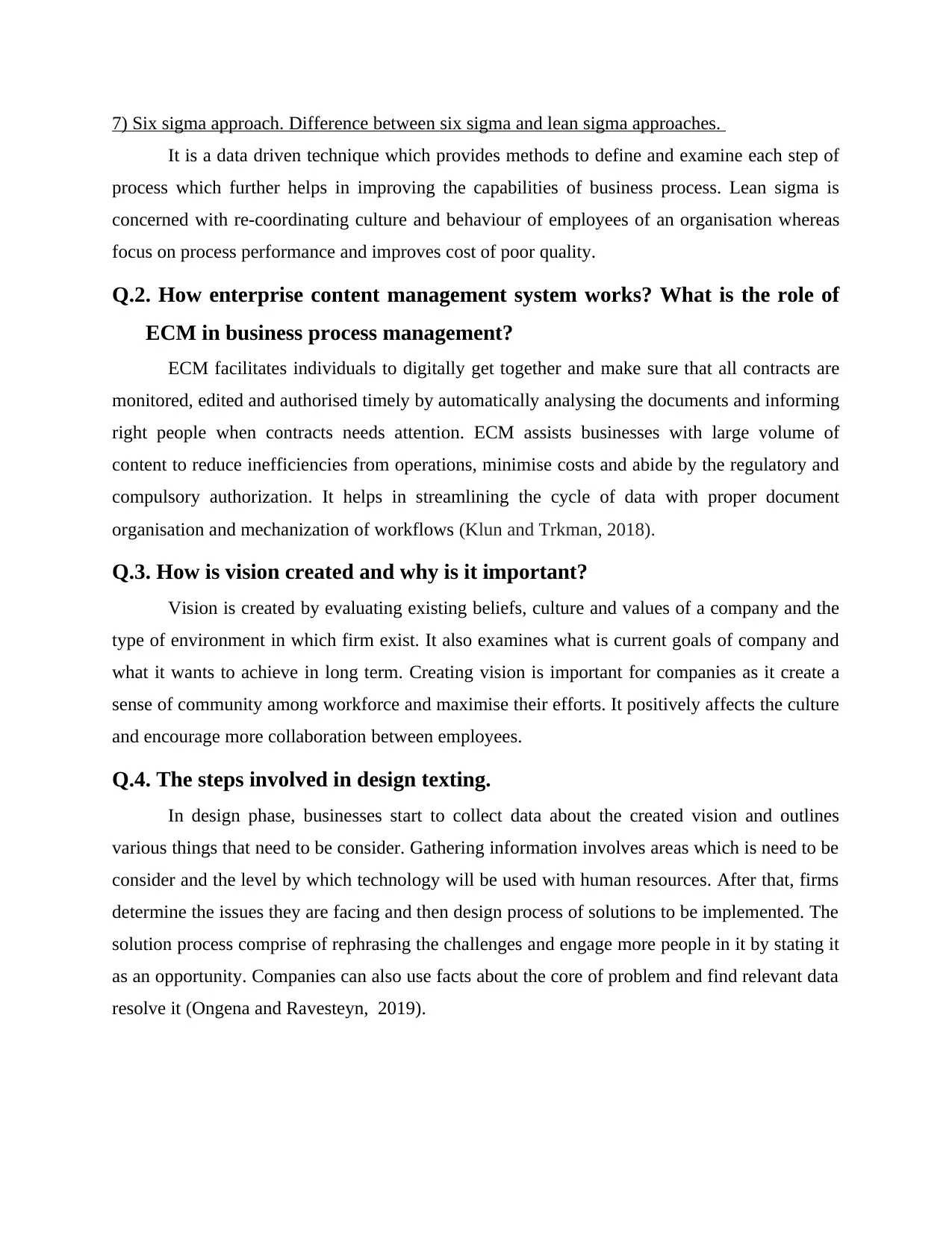
7) Six sigma approach. Difference between six sigma and lean sigma approaches.
It is a data driven technique which provides methods to define and examine each step of
process which further helps in improving the capabilities of business process. Lean sigma is
concerned with re-coordinating culture and behaviour of employees of an organisation whereas
focus on process performance and improves cost of poor quality.
Q.2. How enterprise content management system works? What is the role of
ECM in business process management?
ECM facilitates individuals to digitally get together and make sure that all contracts are
monitored, edited and authorised timely by automatically analysing the documents and informing
right people when contracts needs attention. ECM assists businesses with large volume of
content to reduce inefficiencies from operations, minimise costs and abide by the regulatory and
compulsory authorization. It helps in streamlining the cycle of data with proper document
organisation and mechanization of workflows (Klun and Trkman, 2018).
Q.3. How is vision created and why is it important?
Vision is created by evaluating existing beliefs, culture and values of a company and the
type of environment in which firm exist. It also examines what is current goals of company and
what it wants to achieve in long term. Creating vision is important for companies as it create a
sense of community among workforce and maximise their efforts. It positively affects the culture
and encourage more collaboration between employees.
Q.4. The steps involved in design texting.
In design phase, businesses start to collect data about the created vision and outlines
various things that need to be consider. Gathering information involves areas which is need to be
consider and the level by which technology will be used with human resources. After that, firms
determine the issues they are facing and then design process of solutions to be implemented. The
solution process comprise of rephrasing the challenges and engage more people in it by stating it
as an opportunity. Companies can also use facts about the core of problem and find relevant data
resolve it (Ongena and Ravesteyn, 2019).
It is a data driven technique which provides methods to define and examine each step of
process which further helps in improving the capabilities of business process. Lean sigma is
concerned with re-coordinating culture and behaviour of employees of an organisation whereas
focus on process performance and improves cost of poor quality.
Q.2. How enterprise content management system works? What is the role of
ECM in business process management?
ECM facilitates individuals to digitally get together and make sure that all contracts are
monitored, edited and authorised timely by automatically analysing the documents and informing
right people when contracts needs attention. ECM assists businesses with large volume of
content to reduce inefficiencies from operations, minimise costs and abide by the regulatory and
compulsory authorization. It helps in streamlining the cycle of data with proper document
organisation and mechanization of workflows (Klun and Trkman, 2018).
Q.3. How is vision created and why is it important?
Vision is created by evaluating existing beliefs, culture and values of a company and the
type of environment in which firm exist. It also examines what is current goals of company and
what it wants to achieve in long term. Creating vision is important for companies as it create a
sense of community among workforce and maximise their efforts. It positively affects the culture
and encourage more collaboration between employees.
Q.4. The steps involved in design texting.
In design phase, businesses start to collect data about the created vision and outlines
various things that need to be consider. Gathering information involves areas which is need to be
consider and the level by which technology will be used with human resources. After that, firms
determine the issues they are facing and then design process of solutions to be implemented. The
solution process comprise of rephrasing the challenges and engage more people in it by stating it
as an opportunity. Companies can also use facts about the core of problem and find relevant data
resolve it (Ongena and Ravesteyn, 2019).
Paraphrase This Document
Need a fresh take? Get an instant paraphrase of this document with our AI Paraphraser
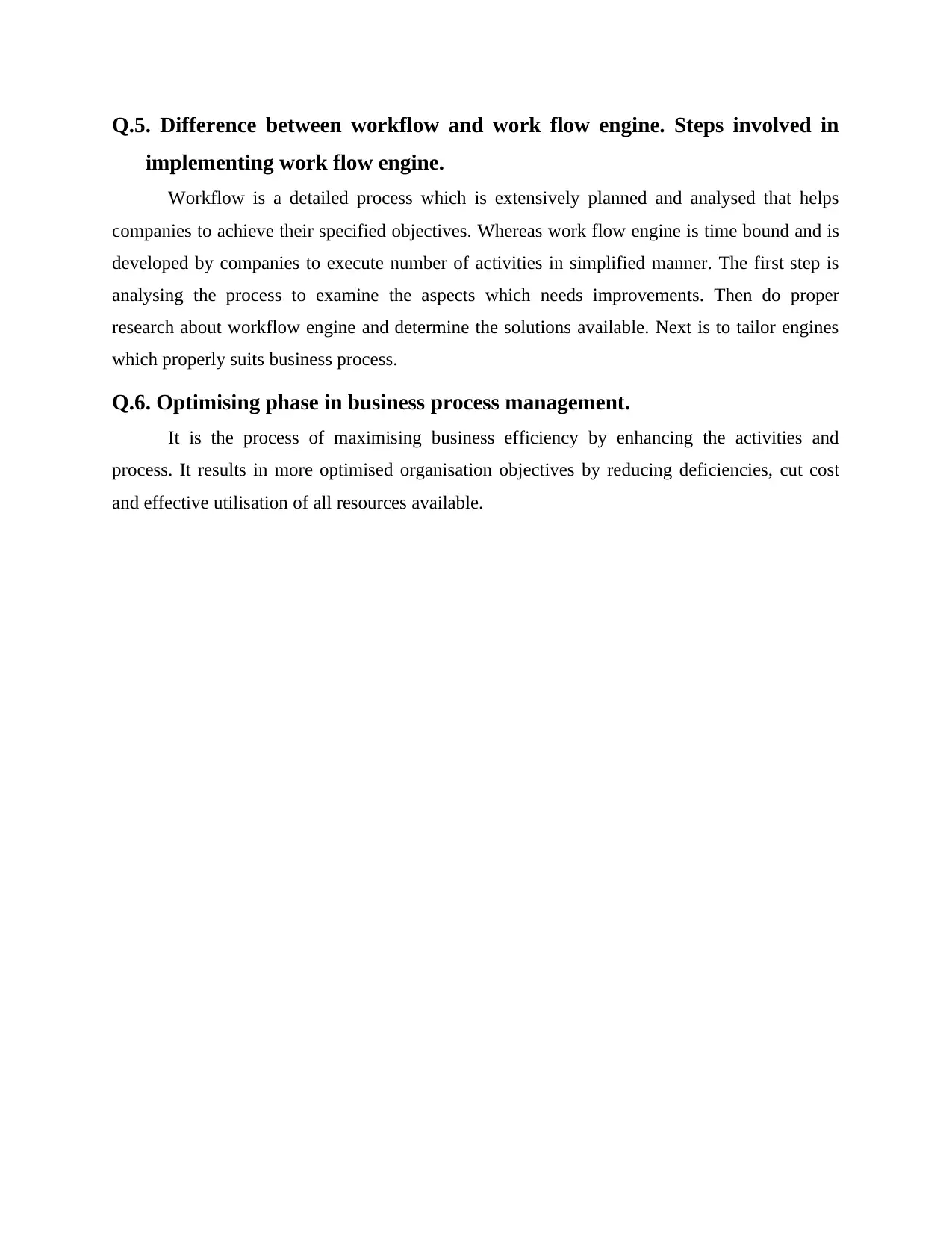
Q.5. Difference between workflow and work flow engine. Steps involved in
implementing work flow engine.
Workflow is a detailed process which is extensively planned and analysed that helps
companies to achieve their specified objectives. Whereas work flow engine is time bound and is
developed by companies to execute number of activities in simplified manner. The first step is
analysing the process to examine the aspects which needs improvements. Then do proper
research about workflow engine and determine the solutions available. Next is to tailor engines
which properly suits business process.
Q.6. Optimising phase in business process management.
It is the process of maximising business efficiency by enhancing the activities and
process. It results in more optimised organisation objectives by reducing deficiencies, cut cost
and effective utilisation of all resources available.
implementing work flow engine.
Workflow is a detailed process which is extensively planned and analysed that helps
companies to achieve their specified objectives. Whereas work flow engine is time bound and is
developed by companies to execute number of activities in simplified manner. The first step is
analysing the process to examine the aspects which needs improvements. Then do proper
research about workflow engine and determine the solutions available. Next is to tailor engines
which properly suits business process.
Q.6. Optimising phase in business process management.
It is the process of maximising business efficiency by enhancing the activities and
process. It results in more optimised organisation objectives by reducing deficiencies, cut cost
and effective utilisation of all resources available.
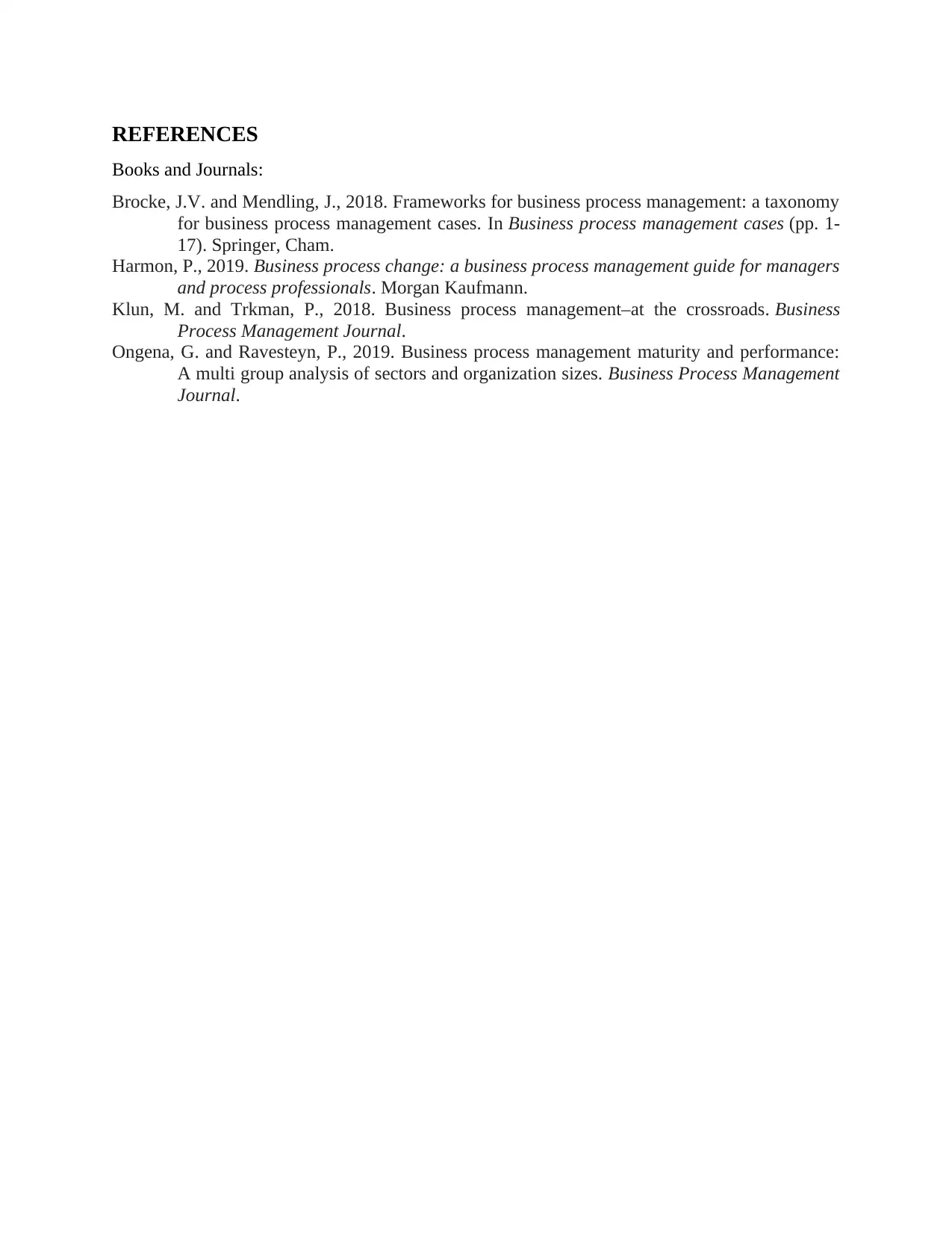
REFERENCES
Books and Journals:
Brocke, J.V. and Mendling, J., 2018. Frameworks for business process management: a taxonomy
for business process management cases. In Business process management cases (pp. 1-
17). Springer, Cham.
Harmon, P., 2019. Business process change: a business process management guide for managers
and process professionals. Morgan Kaufmann.
Klun, M. and Trkman, P., 2018. Business process management–at the crossroads. Business
Process Management Journal.
Ongena, G. and Ravesteyn, P., 2019. Business process management maturity and performance:
A multi group analysis of sectors and organization sizes. Business Process Management
Journal.
Books and Journals:
Brocke, J.V. and Mendling, J., 2018. Frameworks for business process management: a taxonomy
for business process management cases. In Business process management cases (pp. 1-
17). Springer, Cham.
Harmon, P., 2019. Business process change: a business process management guide for managers
and process professionals. Morgan Kaufmann.
Klun, M. and Trkman, P., 2018. Business process management–at the crossroads. Business
Process Management Journal.
Ongena, G. and Ravesteyn, P., 2019. Business process management maturity and performance:
A multi group analysis of sectors and organization sizes. Business Process Management
Journal.
⊘ This is a preview!⊘
Do you want full access?
Subscribe today to unlock all pages.

Trusted by 1+ million students worldwide

Paraphrase This Document
Need a fresh take? Get an instant paraphrase of this document with our AI Paraphraser

1 out of 8
Related Documents
Your All-in-One AI-Powered Toolkit for Academic Success.
+13062052269
info@desklib.com
Available 24*7 on WhatsApp / Email
![[object Object]](/_next/static/media/star-bottom.7253800d.svg)
Unlock your academic potential
© 2024 | Zucol Services PVT LTD | All rights reserved.





